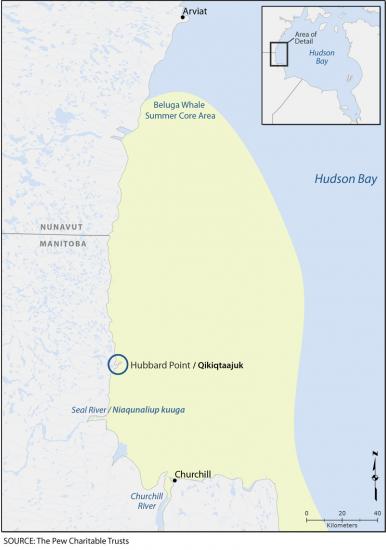1,000-year-old tent rings, as well as food caches, burial grounds and kayak rests can be seen at the site
Source - http://www.cbc.ca/news/technology/ancient-inuit-hunting-camp-to-be-uncovered-in-manitoba-1.2691611

Johnny Mamgark, of Arviat, right, points out stone structures on Hubbard Point to Chris Debicki, of Oceans North Canada, last summer. Mamgark's ancestors have used this site as a hunting camp. (Canadian Press)
On the western coast of Hudson Bay in northern Manitoba there's a gravelly cliff, covered in grass and large rocks, with a 360-degree view of the stark and wild area around it.
It doesn't look like much to the untrained eye, but some 400 years before Europeans set foot in North America, the cliff was a thriving hunting camp for the ancestors of today's Inuit.
Today, there are remnants of 22 large tent rings, as well as food caches, burial grounds and kayak rests — all estimated to be about 1,000 years old.
Researchers are heading to the site, just south of the Manitoba-Nunavut border, next weekend to carefully excavate for animal bones and tools in the hope of gaining insight into the lives of the ancient Inuit known as the Thule.
"Our Manitoba coastline is our best-kept secret. We don't talk about it much and yet we have this very vibrant coastline that has been home to a lot of people over a very long period of time," said Virginia Petch, the project's chief archaeologist. "We're hoping that the kinds of structures we find, and maybe some of the tools we find, will help to give us some connection with the High Arctic."
Petch first stumbled on the site 17 years ago when she spotted the tent rings from the air. She didn't stay long when she reached the site by foot because a half-dozen polar bears were "surveying us for lunch."

She was able to determine the settlement was likely to be 1,000 years old, since there was no evidence of metal. The tent rings are huge, she said, almost as though they were made "by giants." Some tents were positioned in a figure eight, suggesting an extended family lived together.
It was — and still is — a perfect place to hunt and gather food for a harsh winter.
"It was very safe," Petch said. "You could see the beluga coming in. You could see the seals. If you looked inland, you could see caribou and you could watch out for bears. There would be fish in the river. It was a very productive area for people to be."
Believed to be 1,000 years old
Petch and a team consisting of marine biologists, elders, research assistants and a Nunavut student plan to spend a week mapping the site and studying whatever settlement remnants they can find. The burials will remain untouched.
The Thule first settled in Alaska before moving eastward into Arctic Canada and Greenland about 1,000 years ago. They are thought to have had some contact with the Vikings when the Norse reached Canadian shores in the 11th century.

These stone caches would have been used to store food at the Inuit hunting camp. (Canadian Press)
The ancestors of today's Inuit relied heavily on bowhead whales, using their meat for food, blubber for oil and bones for building homes and making tools.
The southwestern coast of Hudson Bay is home to one of the largest concentrations of belugas in the world when sea ice recedes in the summer. About 60,000 belugas migrate to three Manitoba estuaries to feed, give birth and nurse their young.
Kristin Westdal, marine biologist with Oceans North Canada, has been studying the whales for several years and is hoping to learn more about them through the history of the Thule.
The archaeological survey is being conducted by Inuit Heritage Trust and The Pew Charitable Trusts Oceans North Canada as part of its research into the Hudson Bay ecosystem.
"People often forget that Manitoba is a marine province," said Westdal. "This site is there because the people in the region came to that area to hunt the beluga. This is a very important site in the area for marine mammals and also for the Inuit people."